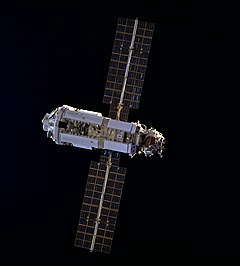
Back زاريا Arabic Заря (модул) Bulgarian জারিয়া (আইএসএস মডিউল) Bengali/Bangla Zarià (Estació Espacial Internacional) Catalan Zarja Czech Zarja Danish Sarja German Zaryá Spanish Zarja (moodul) Estonian زاریا (ماژول ایستگاه فضایی) Persian
 | |
| Module statistics | |
|---|---|
| COSPAR ID | 1998-067A |
| Launch date | 20 November 1998 (25 years ago) |
| Launch vehicle | Proton-K |
| Mass | 19,323 kg (42,600 lb)[a] |
| Length | 12.56 m (41.2 ft) |
| Diameter | 4.11 m (13.5 ft) |
| Configuration | |
 Parts of Zarya[b] | |

Zarya (Russian: Заря, lit. 'Dawn'[c]), also known as the Functional Cargo Block (Russian: Функционально-грузовой блок), was the inaugural component of the International Space Station (ISS). Launched on 20 November 1998 atop a Proton-K rocket, the module would serve as the ISS's primary source of power, propulsion, and guidance during its early years. As the station has grown, Zarya's role has transitioned primarily to storage, both internally and in its external fuel tanks.[2] A descendant of the TKS spacecraft used in the Salyut programme, Zarya was built in Russia but its construction was financed by the United States. Its name, meaning "dawn," symbolizes the beginning of a new era of international space cooperation.[3]
- ^ Hendrickx, Bart (15 October 2015). "From Mir-2 to the ISS Russian Segment" (PDF). BIS. Retrieved 24 May 2020.
- ^ "Zarya Module". NASA. Archived from the original on 18 November 2023. Retrieved 19 April 2014.
- ^ Zak, Anatoly (15 October 2008). "Russian Segment: Enterprise". RussianSpaceWeb. Archived from the original on 11 August 2023. Retrieved 4 August 2012.
Cite error: There are <ref group=lower-alpha> tags or {{efn}} templates on this page, but the references will not show without a {{reflist|group=lower-alpha}} template or {{notelist}} template (see the help page).
© MMXXIII Rich X Search. We shall prevail. All rights reserved. Rich X Search